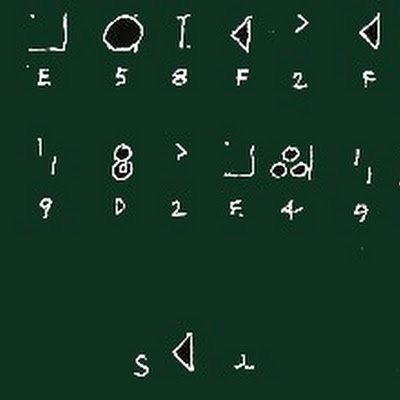Fermilab's Wilson Hall after the discovery of the top quark; note the mysterious reflection in the water...
In March 2007, the Fermilab has received a mysterious, hand-written, encrypted message:
medium resolution, very high resolution.It is apparently constructed out of three or four parts. The first part and the last part have been apparently decoded. At least "most of the information" in them has been translated into a "much more comprehensible" message than the gibberish you see on the paper.
Commercial: Chicago Tribune published a story about the cryptogram on July 11th, 2008In the first part, the symbols I,II,III are interpreted as ternary (base-three) digits 1,2,0. These digits are subsequently clustered into triplets and the triplets 000, 001, 002, ..., 221, 222 are translated as [space], A, B, ..., Y, Z: note that there are exactly 26+1 = 3^3 letters in the English alphabet including the [space].
The third part uses a similar ternary code except that the ternary digits must be first extracted from the number of the individual I lines in between the separators II that isolate the ternary digits from each other. So even though you could think that the last part is binary in character, a simple pre-processing shows that it is ternary, too.
When you use all the insights above that have been independently figured out by two IT geeks who interact with the blogosphere (see the links at the bottom), you decode parts of the letter as:
- FRANK SHOEMAKER WOULD CALL THIS NOISE
- [cryptic hexadecimal digits with corresponding symbols]; sFC
- EMPLOYEE NUMBER BASSE SIXTEEN
The middle part with the symbols - see above - hasn't yet been cracked; I've dedicated the task a few hours, too. There are numerous hypotheses what this part - and the three characters at the end of it - mean. People talk about the misspelled word "BASSE", too. It means "low" or "below" in French. I would bet it is an irrelevant typo (much like some slightly irregular spacing in the understood portions of the text). It just emphasizes that the middle part of the letter is probably written in the hexadecimal form.
The three characters at the bottom part of the middle portion contain "s" and the symbolic codes associated with "FC". Because the symbol "s" isn't defined in the symbolic alphabet in the previous two lines of the middle portion, it is widely believed that it could stand for one of the two hexadecimal characters that are missing at the previous two lines, namely 1 or A. So the three letters mean either SFC, 1FC, or AFC. Or just FC because you should ignore one "S" much like you should ignore it in the word "BASSE" (is it a hint and not just a typo?).
Consequently, 1FC or AFC can be hexadecimal codes of the employee number of a relevant Fermilab employees. The employee whose code is FC only denies any relationship with the letter.
I am convinced that the people who play with this letter should focus on decoding the long hexadecimal middle portion of the letter. I've tried to convert it (and various substrings - individual lines - or permutations of it - e.g. string read vertically) from the hexadecimal form to the decimal digits, ternary digits, trying to use the same cute code based on the ternary triplets that is used in the well-known parts of the message. So far, no clear result. (Be careful, the converter I linked is only accurate in the first 30 ternary digits or so, because of rounding.)
Of course, it is possible that the hexadecimal sequences are UUencoded, or that they even give you a small JPG or MP3 or ZIP or otherwise compressed file. ;-) I find it is unlikely. The text should mean something and my bet is that the middle segment is not radically more difficult than the two segments that have already been cracked. In my opinion, the hexadecimal character of the text together with the ternary code should be taken very seriously and combined or recombined in a way that no one has tried so far.
Codes and physics
I would like to argue that this cracking process is somewhat - remotely - analogous to decoding the mysteries of Nature. The mysteries may be deep but when you find something nontrivial, you are usually damn certain that you are on the right track.
For example, at some moment, the people got pretty certain that it is a ternary code even though they had no idea what it was saying. At a different moment, when they saw the letters "FRANK" or "EMPLOYEE" for the first time, they had to be almost certain that they are approaching a full understanding of the relevant portion of the text. The probability that such an agreement of decoded observations with a simple theory (based on "special" words) works by chance is negligible.
You don't need any new experiments. It had to work. Subtle is the Lord, but malicious He is not. (And the author of the letter could be somewhat more malicious and disordered than the Lord but not too much.) Theoretical physicists are often comparably certain. You often need a few hints only - hints that couldn't occur by chance.
Nature makes sense but most theories one could invent predict gibberish. If a theory predicts meaningful results that moreover agree with a couple of facts about Nature that couldn't really occur accidentally, you know that there is something about it. Sometimes you know that you have learned the whole theory; sometimes you know that you have cracked a part of the mystery and reduced the task to a much more specific and more well-defined task than one you faced previously.
Via John Conway, Fermilab Today, Symmetry Magazine, SlashDot, Geoff Milburn (a successful cracker), John Graham-Cumming (another successful cracker).
Frank Shoemaker & encrypted message
 Reviewed by DAL
on
May 21, 2008
Rating:
Reviewed by DAL
on
May 21, 2008
Rating:


No comments: